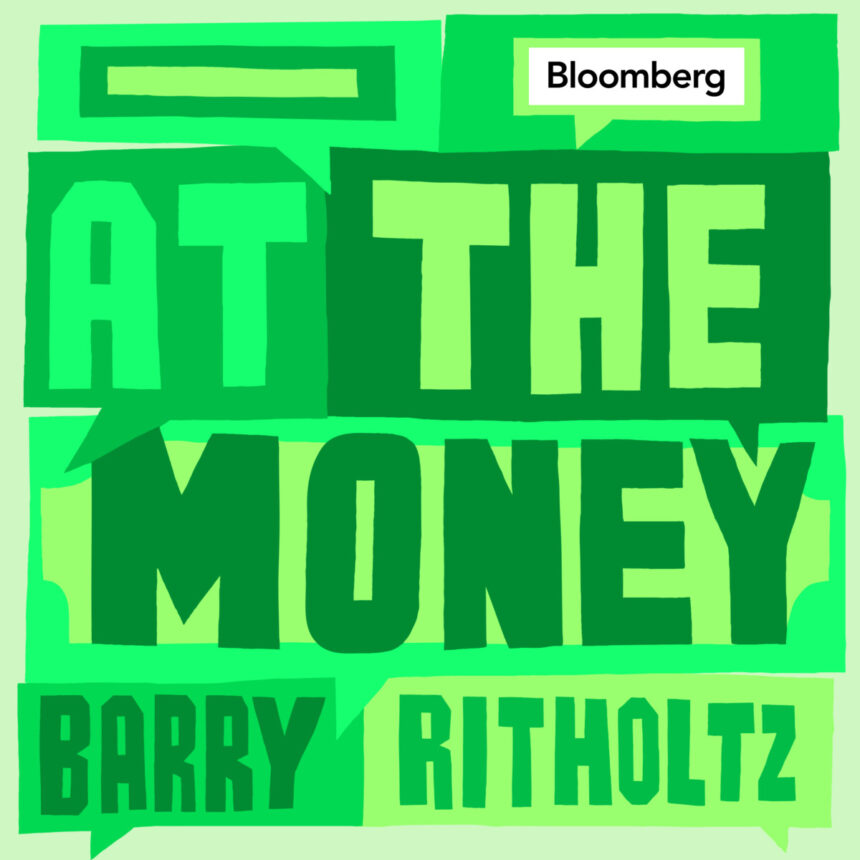At The Money: The Right Way to Spend Your Money in Retirement (July 16, 2025)
One of the biggest challenges of retirement is actually spending your money! After decades of working, saving, and investing, pivoting to spending down your accumulated wealth can be surprisingly difficult.
Full transcript below.
~~~
About this week’s guest:
Christine Benz is Director of Personal Finance & Retirement Planning at Morningstar; her new book is “How to Retire: 20 Lessons for a Happy, Successful, and Wealthy Retirement.” She joins Barry Ritholtz to discuss what you need to know about planning for retirement.
For more info, see:
Book: How to Retire: 20 lessons for a happy, successful, and wealthy retirement
~~~
Find all of the previous At the Money episodes here, and in the MiB feed on Apple Podcasts, YouTube, Spotify, and Bloomberg. And find the entire musical playlist of all the songs I have used on At the Money on Spotify
TRANSCRIPT:
Speak to any financial advisor and they’ll tell you one of the biggest challenges they have professionally is getting clients to actually spend their money after decades of working and saving and investing. Making the turn to spending money can be a challenge.
I’m Barry Ritholtz and on today’s edition of At The Money, we’re gonna discuss spending your moolah in retirement.
To help us unpack all of this and what it means to your retirement, let’s bring in Christine Benz. She is the Director of Personal Finance and Retirement Planning at Morningstar. She’s published numerous books on money investing and retirement. Most recently, “How to Retire: 20 Lessons for a Happy, Successful and Wealthy Retirement.”
So, so let’s start with the basic problem. Getting those type A personalities who are used to working and saving and working and investing to kind of pivot to working and spending is a big challenge. How big of an issue is this amongst people who are looking at retirement? It’s a very big issue and it’s kind of, you know, a difficult topic to talk about because we have a lot of people in our society who are quite under saved, uh, relative to what they will need for retirement.
They’ll be exclusively dependent on social security, but there’s also a. Segment of our population who struggles with spending appropriately. I can’t tell you Barry, how many times I’ve been out speaking to a group of older adults and I’ll have someone come up at the end of one of my sessions, clearly in his or her eighties, usually his, um, based on the com composition of the audiences I usually speak with.
Um, and he’ll proudly say I only spend 2% of my portfolio per year, whatever the value is. That’s what I spend. And I kind of think to myself, well, gosh, I hope that that delivers you a good quality of life. And I also think to myself, you’re probably pretty significantly short changing yourself if you’re just spending at, at that level.
And as you said, Barry, I hear this from financial advisors as well, that they struggle getting their clients to spend appropriately. I, I heard, um, a funny line from, um, a parent. Older clients who were getting on a plane and they were sitting in first class and they bump into friends they know who are sitting in coach, and the conversation was they just could imagine each other’s conversation.
Look at them sitting in the front of the plane, spending their kids’ inheritance, and then the one sitting in the front of the plane saying, can you imagine they’re flying coach so their kids can fly first, ca first class? It’s kind of funny, but ultimately, isn’t this a psychological struggle about not just outliving your own money?
Uh, assuming we’re talking about people who aren’t gonna outlive their own money, there’s still this enormous hesitancy to spend their kids’ inheritance or to spend money when they’ve spent their whole lives as savers. Tell us about that. Exactly. It’s a sense of identity. I think that one builds as a saver and an investor that you are someone who defers gratification.
You set money aside each month and the further you go along in that journey, probably the more successful you are. Um, you get to see the incredible power of compounding. I think there is a common tendency to kind of anchor on the. Portfolio’s, high watermark to think, well, if it’s here, I never wanna see it go lower.
It just does not feel good to see the balance go down after a lifetime of seeing it generally escalate. So there’s a lot going on psychologically and kind of the elephant in the room, um, in this respect is long-term care. Mm-hmm. That people who have. Not purchased long-term care insurance and may have really good reasons to not have done so.
Still have this, uh, risk of like, oh, may I have this balloon payment at the end of my life where, you know, I could get stuck with years and years of expensive care. So I think that that is a real risk factor that that is in the mix as well. Really, really interesting. Um, so since we’re talking about long-term care, let’s talk about generally putting together a personalized plan, thinking about needs and goals, lifestyle considerations.
What should someone who wants to spend more of their money do in order to feel comfortable that they can afford to spend a little cash? Well, I would say, um, either get a financial advisor to help you with this, where they’re effectively dispersing a portion of your portfolio to you per year if you’re doing it on your own.
Get familiar with the research on safe spending rates. A lot of the research that’s been done by our team and others points to the value of. Being flexible with your portfolio withdrawals, where you are taking more, when your balance is up, when the markets are up and you’re taking a little bit less when things are down.
Um, I think if people understand the data that we have on retirement spending, one thing that we know is that people tend to spend less as they age. Um, so you’re. Early years of retirement should be the higher spending years of your retirement because that’s usually when people’s health is good. Um, they are, uh.
They may have pent up demand to do travel. They may be launching adult children. A lot of things going on at that life stage, you should give yourself permission to spend a little bit more early in retirement with the knowledge that even when we look at spending trajectories among very wealthy households, people spend less as they age.
So if you’re okay with that, trade off with the idea that you probably will spend less, you should give yourself a little bit more license to spend earlier on. So, so let’s break those spending desires down. You mentioned travel, like it’s easy to travel in your sixties and seventies than it is in your eighties and nineties.
Um, hobbies, legacy, philanthropy or charitable goals to say nothing of future healthcare needs. How should people organize their thoughts and planning for, for future spending? Yeah, I think it, it’s helpful to get very granular about the budgeting, and I don’t mean you know that you’re nickel and dimming yourself and looking at every line item, but if you have, say, a big family trip planned in year two of your retirement, spend some time figuring out what the implications will be.
For your plan, for your spending in that year. Know that those big outlays won’t occur every year, but actually spend some time mapping them out. And the nice thing about that is that in addition to it helping your spending plan, it will also help you get these plans off the ground, rather than having them as some, you know, sort of vague notion of.
Of things that you want to do. Um, you mentioned lifetime giving Barry to family members and charity. I have come to be a huge evangelist for this because when we look at the data on when people inherit money from their parents, they’re usually in their fifties or in their sixties. Their financial fortunes are pretty well set by that life stage.
Whereas if you have young people in your life, whether children, grandchildren, nieces, nephews, you can make a. Big impact for them in that the twenties, thirties, forties, um, with home down payments or paying off student loans. And these don’t need to be big ticket gifts. Smaller gifts can make a big impact.
I often talk about how my mom and dad gave my husband and me a little bit of padding for our home down payment on our first home, and that helped us get into a home that we were able to. Day in for 12 years, we lived it exactly in the community where we wanted to live. So having that discussion with your loved ones about the gifts that might help them, I think is, um, something that can add a lot of richness to someone’s retirement.
I recall reading your piece, what was it in the fall last year or maybe, uh, around, around the holidays? Um, inter vivos transfers is the technical term, right? While you’re alive. This seems to be increasingly modern development. Like I think back 25, 35 years, you didn’t hear that much about it, at least outside of the top one or 5%.
Now it’s fairly common for the X or boomer generation to help with a down payment or college, as you mentioned. Tell us about what you’re seeing out in the world. How significant has this become? Is this, um, something around the fri fringes, or are we seeing a lot more intr vivos transfers today than say, 20, 30, 40 years ago?
I don’t have any data on it, Barry, but my sense is that the movement to toward lifetime giving is picking up steam and not just for very wealthy people. I think sometimes people are put off by the term lifetime giving. It sounds very high brow, but it doesn’t have to be. It can be assistance with some of those smaller, um, life achievements that that young people might.
Might wanna tick off their list. So I would urge planners and individuals pursuing their own retirement plans to think about building in some of those lifetime, uh, giving, uh, aspirations. And also, you know, there are really nice tax planning mechanisms that people can use to help them achieve, achieve those things as well.
Um, the donor advised fund for charitable gifts, especially. And why shouldn’t you see family members, friends, whoever enjoy the benefits of your large S while you’re still around? It shouldn’t be just something you think about when you’re at your estate attorney and you’re signing a document and that’s the last you see of it.
Why not get to enjoy your, your kids or nephews or whoever in a new house that you helped them get there? Exactly that. That is the huge side benefit of contemplating lifetime giving, so, so let’s talk about a little more formal type of giving. You mentioned donor-advised funds, uh, philanthropy when it comes to both financial and estate planning.
Philanthropy is a big part of both retirement and estate planning. Talk a little bit about the idea behind. How families should be thinking about, um, managing philanthropy or donating to causes that are near and dear to their heart. Yeah, get, get some advice on the tax aspect of this.
The donor advised fund is a really nice mechanism for people of varying means, and it’s especially appropriate for people who have concentrated positions in their portfolios, often employer stock, where you can kind of take a risk out of the portfolio, uh, and donate the, say, employer stock to the donor advised fund.
You can get, uh, a. A tax deduction on that contribution. And you can also, uh, remove the capital gains tax associated with that big gain in the position at, at the same time. And then from there on, once you’ve established the donor advised funds, you can make those. Those charitable gifts on an ongoing basis.
So that’s one strategy that I would say would be kind of a first line, uh, to consider for, for people of all levels of wealth. And then for people who are moving up and getting into retirement, um, using the, uh, the, the charitable qu. Qualified charitable distribution from IRAs can be a really nice strategy as well where you are giving a portion of your IRA once you pass age 70 and a half to charity and the, we’ve seen a little in inflation adjustment in the amount that you can give, but it’s now over a hundred thousand dollars per year.
It’s a way to reduce the tax burden associated with, um, that IRA. So that’s another strategy to consider. I just wish it were. Um, available to people of, of all ages where you could potentially lighten up your IRAA little bit and, and get a tax break and do some charitable giving. So we’re talking about spending in retirement and, but we have yet to talk about drawing down portfolios.
Um, uh, bill Sharp, Nobel Laureate, uh, and, and a key, uh, person when it comes to both modern portfolio theory and understanding. Asset allocation has called this the thorniest problem in all of finance. Why is figuring out. How much to draw down your portfolios, whether just to live on it or for special spending.
Why is that such a challenging, um, set of numbers? The key issue is that you’re dealing with a bunch of wildcards, so you have an uncertain time horizon. You don’t know how long you’ll live, and you may have a little bit of a window into that as you age, but most of us do not have that crystal ball, and then we don’t know how the markets will perform over our retirement time horizon.
And then this recent inflation shock really illustrated the wild card that inflation is. For retirement plans. So you don’t know how inflation will, um, play out over your horizon, so you don’t know how much you’ll have to elevate your spending just to kind of keep your head above water. So all of those things are super tricky to get.
To get your arms around And the key conclusion for a lot of people is like, well, I’d rather be safe than sorry. I’d rather be a little bit conservative if it means a very high likelihood that I won’t run out. Um, but I do think the kind of one and done withdrawal rate, the 4% style guideline is, you know, maybe a good proxy if you’re 50 and trying to figure out if you have enough.
But it’s not a retirement. Spending plan because people don’t spend that way. They don’t just spend the same amount in a straight line adjusted for inflation throughout retirement. It’s lumpier. So you have a sequence of return problem on the asset side, and then you have a front loaded spend on the consumption side.
That sounds like that could be potentially challenging with just a straight up 4%. Definitely. And then long-term care, which we talked about earlier, that’s another wild card in the mix. So how often should retirees be reviewing their holdings? How often should they be making changes to their budgets? Is this a set and forget, or do you need to regularly be updating this?
I like the idea of doing it once a year as kind of a holistic strategy where you’re checking up on your withdrawal rate, you’re looking at what your portfolio could support in the year ahead, and you’re doing a little bit of portfolio maintenance. So I’m a big believer in the bucket approach to retirement income.
If you’ve spent from that cash bucket in the previous year, you’re also looking at your portfolio and. Deciding, well, where is a sane place for me to pull from if I need to top up that cash bucket to provide me with spending money in the year ahead? And you’re also doing a little bit of tax planning as well.
So if you’re subject to required minimum distributions, for example, you’re figuring out where to where to go for them. So I think a good one, stop holistic portfolio review is, is fine for most retirees. And our final question. You talked about the difference between retirement spending and legacy planning.
Explain to listeners what that difference actually is. So, uh, I’m not sure how to answer that question, Barry. Um, and it, it came from your article about your parents helping you with the down payment. Okay. Okay. Could you ask me again? Sure. So in the article you wrote about spending while you’re still alive, talking about how your, your folks help you and your husband with the down payment for your first house, and how much that was, uh, a significant change to you guys personally explain the difference between simple retirement spending and legacy planning.
The term spending, I think is super loaded. When we tell people they should be able to spend X in retirement, I think they automatically jump to it means we’re telling them to buy cars every year, even if they don’t need a new one or go out to dinner every night. Even if. That’s not really something they wanna do.
And so I think this term spending is kind of loaded, and maybe we’re a little bit judgy about it, but I would urge people to think broadly about retirement spending and use their retirement spending. To do some legacy planning. So, you know, the example of our home down payment is one way that I think my parents pursued legacy.
They, um, you know, certainly made an impact on our lives. They kept us nice and close to them so that we were able to help them later in life because we lived nice and close by. So I would urge people to think bigger about retirement spending, that it should encompass some of these legacy goals and you should give your.
Yourself permission to gift to your loved ones during their lifetimes and during your lifetime. So to wrap up, everybody needs to plan for retirement, but we also need to think about our spending. The odds are that we’re gonna spend more in the early parts of our retirement when we’re still younger and more mobile than the latter part of our retirement.
And we really need to think about the prior. Standard of waiting till you are deceased for the monies to find its way to the rest of your family. Assuming you have enough money to live on and that you’re not gonna outlive your cash, don’t be afraid to spend a little money. Don’t be afraid to donate a little money, whether it’s family members or charity, while you’re still alive and while you could see the benefits of your generosity, uh, with your own eyes.
I’m Barry Rithltz. You are listening to Bloomberg’s. At the money.
~~~
Find our entire music playlist for At the Money on Spotify.











